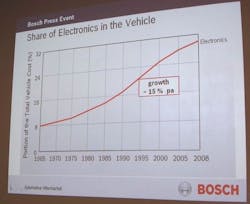Electronics are steadily taking over light vehicle operations. Bosch’s Jim Frazer believes the share of electronics in a vehicle will reach 40% in 2011. An increase in the popularity of the electric vehicle would make the changes more rapid.
For the technician, even the simplest of services will require “knowledge, training and know-how” in addition to equipment, said Frazer, director of marketing for the Bosch Group’s Diagnostics Business Unit. “The car has literally become a computer.”
As the vehicle continues to evolve, it will become “a super computer with a rolling IP address!”
Frazer, speaking to the press at the introduction of the Bosch KTS 340 mobile diagnostic tool (see “Bosch designs diagnostic tool for North America”), listed a number of technology trends that incorporate the need for electronics:
* alternative energy supplies (hydrogen gas, fuel cell);
* dynamic navigation telematic systems;
* brake-by-wire (see www.brakebywire.com);
* car management system Cartronic;
* cockpit modules and instrument clusters;
* high-pressure diesel injection systems;
* adaptive cruise control;
* direct petrol injection;
* steer-by-wire;
* ABS/ASR ESP;
* modern lighting technology; and
* passenger safety systems (such as airbags).
“The relevant car park (i.e., vehicles on the road) of the future will change radically… (there) could even be car-to-car communication down the road.”
Safety continues to be the impetus for a lot of the changes. Frazer said “predictive emergency breaking,” in which the car takes into consideration the speed, inertia and the weight of the vehicle, is possible.
(He also promoted Bosch’s “Combined Active & Passive Safety,” or CAPS, concept, which the company defines as “an intelligent modular safety system that protects vehicle occupants and other road users via new functions. Through the networking of active and passive safety, as well as driver assistance systems -- which had previously operated independently -- CAPS contributes to crash avoidance and mitigation.”)
Independent systems are increasingly becoming interconnected, he said. An error in one system can lead to a malfunction in another, so tracing the error from the source alone is no longer sufficient.
As diagnostic test equipment and software become interconnected with information and knowledge systems, smarter guidance and support in diagnosing problems is necessary, said Frazer, who suggests independent tire dealers and repair shops should start preparing now.
“This is coming faster than a lot of people think.”




